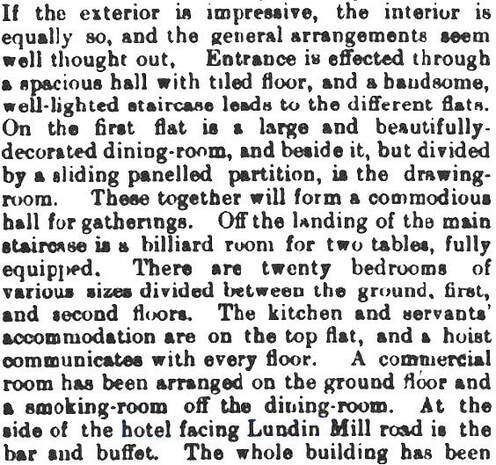With the sad loss of the Lundin Links Hotel building this week, due to a major fire, it feels appropriate to revisit the history of this iconic landmark. The next few blog posts will remember the hotel as it was intended to be - a place that people gathered for enjoyment and relaxation. The above sketch of the brand new hotel appeared in 31 May 1900 Leven Advertiser and reminds us that when the hotel first opened its doors, travel was still primarily horse-drawn. The late Victorian era was a time of rapid development in Lundin Links. The late 1890s saw a row of shops built opposite the hotel site on Leven Road. Many new villas and boarding houses were springing up to meet demand for accommodation.
The old inn, which pre-dated the hotel, had been bought in 1897 by James McTavish, who had the vision of demolishing it and building a modern, up-market hotel to cater for the golfers and summer visitors that flocked to Lundin Links. Construction of the new hotel was hindered when McTavish was declared bankrupt in March 1899. Three individuals stepped in to save the project (with McTavish retained as manager). The new investors (shown from left to right in the image below) were Samuel Duncan (McTavish’s father-in-law, a tailor from Edinburgh), Peter Henderson (the architect of the hotel), local man businessman William Bethune . All men were keen golfers and the hotel was conveniently close to Lundin Golf Club, of which Henderson was Captain at the time.
The 1899 photograph above shows the hotel part-built. At this point the roof was yet to be completed and the west side of the hotel was not yet up to its full height. The second floor arched window spaces were present but incomplete. Construction of the west-wing of the third floor was yet to be started. The hotel was eventually completed for the summer season of 1900, with specially-invited guests attending a preview of the premises in May. The East of Fife Record on 11 May surmised that the hotel "should secure a large clientele among the golfing fraternity". Indeed the guest list for the 24 May opening preview event included a fashionable crowd of golf enthusiasts including Edinburgh furrier John Gerrard, founder of luxury jewellers Hamilton and Inches, Robert Inches, and musician John Kenyon Lees, who had a 'Piano and Music Saloon' on Edinburgh's Frederick Street and was composer of 'The Golf Song Book'.
The smartly-turned out party of locals and visitors can be seen in the photograph above, taken by William Drummond Young of Edinburgh (and featured in June 1900 Golf Illustrated magazine). All of this commotion and change must have been quite bewildering for the older residents of Lundin Mill. The Leven Advertiser piece recognised that one "cannot pass Lundin Links without being struck with the thorough way in which modern buildings have entirely obliterated the village, even to the name, Lundin Links, coming trippingly off the tongue of all save the older natives."
In fact the old inn had not been entirely demolished at the time of the opening of the new hotel and stood in stark contrast to the "new hotel resplendent in its fresh paint, flags and draperies." However, it was noted that the old "deserving institution" had to "give place to a building more suited to the wants of this growing and popular watering place". The modern design of the new hotel was an example of a fashion for red brick work coupled with half-timbering. The Leven Advertiser provided a detailed description of the interior, which included a flexible space on the first floor featuring a sliding partition.
The varied facilities had clearly been carefully planned with the target clientele in mind and took advantage of the latest innovations. Other features included electric light powered by an oil engine, modern bathrooms (no longer was there a need to bring your own bath on holiday) and an extensive laundry at the rear. All work was carried out in the "most lavish manner" by the contractors, whose details are provided below.
As well as a tour of the building and a dinner, the 24 May event involved musical recitals and many speeches, paying tribute to the many people involved in achieving completion of the venture. Among the speech-givers was local baker Andrew Thomson who gave reminiscences of the village and golf course as he knew the place 37 years ago. He was one of the six founders of the Lundin Golf Club back in 1868. In another speech, Sir John Gilmour speculated on the type of guests that might visit the new hotel. Aside from the golfing fraternity, he spoke of city-dwelling 'week-enders', seeking some sea air to put colour in their cheeks (see newspaper extract below).
So, the hotel's story got off to a flying start with fashionable guests, amusing speeches, fine dining and musical performances. In the next post, the hotel moves out of the late Victorian era into a more modern age.







 RSS Feed
RSS Feed
